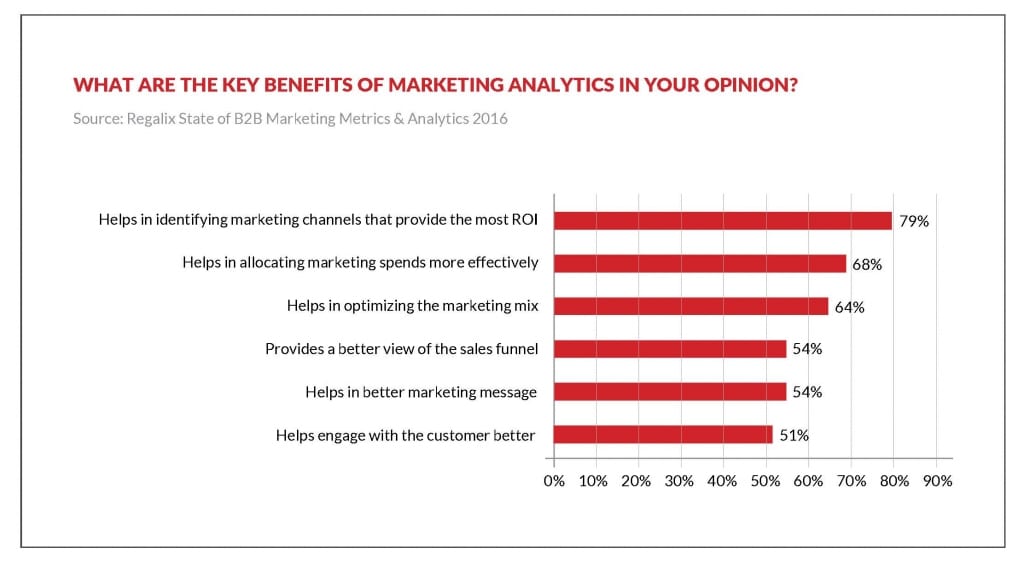Data-driven decision making is increasingly valued above the “trust your gut” way of thinking. In the very beginning, there just were no tools and information needed to conceive and measure the effectiveness of our efforts. We all were forced to rely on our guy feelings when it came to assessing the success of our marketing initiatives.
According to Harvard Business Review, 45 percent of executives “rely more on instinct rather than facts and figures to run their businesses. That’s an alarming statistic!
Even now, as more effective tools to collect analytics are available, many in marketing prefer to trust intuition over data. Intuition is highly valued in C-suites across the country, and acting on gut feelings has been valued over the hard work of crunching data and formulating rational strategies.
The trust in intuition is understandable. But it’s also dangerous. Intuition does have its place in decision-making and you should not ignore your instincts more than you should ignore your conscience – but anyone who thinks that their gut is a substitute for reason is indulging in a risky delusion. Detached from proper analysis, intuition is irresponsible and undependable. It is as likely to lead to disaster as to success.
Unfortunately for marketers driven by creative instinct, today’s businesses are increasing demand for marketing teams to have the ability to show a tangible ROI to justify their budgets. Simply-stated, marketers must do better. Gut feelings just aren’t good enough anymore.
Is it art or science?
Marketers didn’t always have data analytics tools available to enable quantitatively and qualitatively measure the effectiveness of their strategies or campaigns. In the past, determining marketing success really was an intuitive exercise.
John Wanamaker, and early marketing pioneer, once famously said, “I know half my advertising is wasted; the trouble is I don’t know which half.” Despite a growing and acute recognition of the need for more transparency, the technology just wasn’t there.
Neil Borden, who wrote “The Concept of the Marketing Mix” in 1953, started with the following statement that described the state of the art at the time:
“Marketing is still an art, and the marketing manager, as head chef, must creatively marshal all his marketing activities to advance the short and long term interests of his firm.”
He was chiefly interested in determining how the elements of a marketing program could “be manipulated and fitted together in a way that will give a profitable operation.” Borden highlighted the need to ask “what overall marketing strategy has been or might be employed to bring about a profitable operation in light of circumstances faced by management?”
Despite the progress marketers have made toward a “use of the scientific method” to test which configurations of a marketing mix are most effective, Borden was critical about marketing still not achieving the goal of establishing pragmatic marketing science by the 1960s. Marketing remained largely in the “realm of art,” as he put it.
With the development of productivity analysis in the 80s, the trek toward marketing analytics surged ahead. That was followed by enterprise analysis systems in the early 2000s that gave large companies the capability to better track their marketing efforts.
Business intelligence followed, coming together as a coherent discipline in the mid-to late 2000s. It all paved the way for modern data analytics, powered by the bleeding-edge cloud technology, predictive modeling and information for APIs.
Today, we are witnessing a shift in data analytics tools, which continue to become increasingly available to marketers from every type and size of business. Prices are dropping, cloud solutions are enabling mobility, drag-and-drop interfaces are replacing code-based ones, automation and AI are handling the heavy lifting and integrations are bringing silos down.
It’s easy to forget that until this now, effective data analysis was primarily the realm of larger corporations that could afford the (necessary) infrastructure to work with huge sets of unstructured data from various sources. That infrastructure usually included data warehouses, an accompaniment of data analysts, and expensive software to make sense of the data and deliver the results of the data analysis to decision-makers.
That brings us back to the challenge facing today’s executives: How do you analyze more in less time? The answer lies in the technology. Powerful new decision-support tools can help sort through vast numbers of alternatives and pick the best. When combined with experience, insight, and analytical skills of a good management team, the tools offer a way to make consistent sound and rational choices even in the face of baffling complexity – a capability that our guts can never match.

It’s a revolution
Since the shift toward content-based marketing built momentum, marketers find themselves under increasing pressure to measure the effectiveness of their publishing efforts. At the same time, they now have more data available then was ever available in the past.
The number of data sources actively analyzed by businesses is expected to grow by 83 percent between 2015 and 2020, according to the 2015 Salesforce State of Analytics Report. By comparison, the number of data sources only increased by 20 percent between 2010 and 2015.
The big question in not whether marketers can apply the scientific method to available data. The question is now how best to do it? The Salesforce report pointed out, “business leaders face a continued influx of data and still struggle to make sense of it all.”
Trend Watch 2017
These trends are being driven mainly by a wealth of available data and emerging tools to make practical use of that data. The urgency will only intensify as we shift into 2017. According to Marketing Land, the data analytics landscape is primed to undergo some significant evolution in the months ahead. Here are the top trends to track:
Data-driven engagement via automation
The trend that we have seen throughout 2016 will only strengthen in 2017, as the industry continues to demand higher levels of efficiency and effectiveness in an increasingly scrutinized, misunderstood, and competitive environment. According to Acend2, 71 percent of companies currently use marketing automation, and another 23 percent plan to get started with it in the months ahead.
Marketers will have no choice but to increase their investments in marketing tools that are capable of more sophisticated segmenting for targeted engagement with existing and prospective customers.
The tyranny of the bottom line
Marketing has always required a combination of creativity and science- usually more of the former. This has made the impact of marketing trickier to measure accurately and the value even harder to measure. The tides have turned, as marketing has become increasingly data-focused.
The effectiveness of the data revolution in marketing is twofold. On one hand, marketers have far deeper insights into what works and what doesn’t. On the other hand, it means marketers are expected to make more effective use of available data analytics tools to show higher returns.

Tighter collaborations across teams
With greater transparency into all aspects of the customer life cycle, marketing is finally being recognized as a critical contributor to business success, and tighter integrations with the sales team is crucial. Marketing is no longer a fringe group practicing the dark arts that somehow benefit the business.
With activated becoming more directly measurable, the pressure is on for better alignment in terms of evaluation performance. End-to-end business process metrics are merging with one another, and lead qualification criteria are evolving as a result.
You can finally ignore those vanity metrics that don’t make substantive contributions to the bottom line. Insights derived from marketing analytics must be actionable by your sales team who must, in turn, give feedback to your marketing team about leads that do or don’t convert and which lead are more likely to convert, as an example.
This process transforms marketing into a discipline that draws on relevant metrics to deliver practically useful insights and prospects to sales teams to use to realize higher sales and revenue.
Analytics latency is history
Today’s advanced business intelligence tools (think cloud storage solutions and caching algorithms) make it easier to collect data from multiple sources in different formats, analyze the data and extract actionable insights.
The benefits include dramatic cost savings and near-real-time analysis of information accurately merged from distributed sources.
Simply breaking down traditional data silos was a big step toward better efficiency. Analysis with minimal latency means more immediate decisions that often have profound results for rapidly growing businesses based on key goal-based metrics such as:
- Cost of content production and paid customer acquisition,
- Content being distributed effectively,
- True engagement with relevant audience members.
Taking it to the next level
Those who pay attention to the trends heading into 2017 are better positioned to take advantage of new tools to collate, analyze, and act on their data. Ultimately, those are the people who will be able to most effectively determine whether their marketing strategies are working and how best to optimize them.
We’re likely to see increasing demand for data that is more detailed and precise than ever. Those who are capable of drawing insights from data using analytics will leap ahead of lazy marketers who insist on relying on that “gut feeling.”
We can already see the signs of this imminent, fundamental change. They all point to one certain conclusion: Using your gut over data analysis-driven strategy for 2017 is a recipe for failure.
This article originally appeared in Private Lender magazine by AAPL, November/December 2016












Leave A Comment